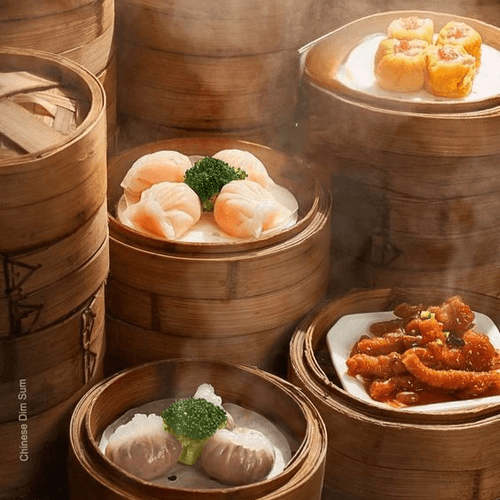
Guangzhou Cuisine — Yum Cha / Early Tea
Yum cha (早茶) in Guangzhou is more than breakfast — it’s a relaxed, social ritual of sharing small plates and tea. Below are six classic (and one modern) dim sum items you should try, written so a first-time foreign visitor understands how they’re made, how they taste, and how to eat them.
Har gow — Shrimp dumplings
How it’s made / seasoning: Fresh shrimp (sometimes chopped, sometimes whole) is lightly seasoned and wrapped in a very thin translucent rice/starch skin, then steamed. Minimal seasoning lets the shrimp flavor shine. Taste / texture / feature: Delicate, slightly chewy wrapper; juicy, clean shrimp flavor. Considered a dim-sum benchmark — a good har gow shows the chef’s skill. Tip for tourists: Eat hot. Try it plain first to taste the shrimp, then add a drop of soy or chili oil if you like.
Siu mai — Pork & shrimp open dumpling
How it’s made / seasoning: A ground-pork (often mixed with shrimp or mushrooms) filling wrapped open on top and steamed; sometimes topped with fish roe or carrot dice. Light soy/sugar/pepper seasoning inside. Taste / texture / feature: Meaty and savory with a springy bite — more “meaty” than har gow. Very approachable for Western palates. Tip for tourists: Great to share. Try it before adding sauces to appreciate the filling’s balance.
Steamed spare ribs with black beans (豉汁蒸排骨)
How it’s made / seasoning: Small rib pieces marinated with fermented black beans (douchi), garlic, a dash of rice wine, then steamed until tender. Taste / texture / feature: Savory, umami-forward, with a distinctive fermented-bean aroma — comforting and “homey.” Tip for tourists: A classic tea-house savory item; pairs well with congee or rice. If you like bold savory flavors, you’ll enjoy it.
Cheung fun — Rice-noodle roll (steamed rice roll)
How it’s made / seasoning: Very thin sheets of rice batter are steamed, filled with shrimp / char siu / or even a piece of fried dough, then rolled and drizzled with a slightly sweet soy sauce. Taste / texture / feature: Silky, smooth wrapper; filling adds contrast. The soy glaze gives a sweet-savory finish. Tip for tourists: Try “har gow cheung fun” (shrimp) or “zha liang” (rice roll wrapped around youtiao — fried dough) for classic contrasts of texture.
Turnip cake (萝卜糕)
How it’s made / seasoning: Grated Chinese radish (daikon) mixed with rice flour and bits of dried shrimp or Chinese sausage, steamed into a loaf, then sliced and pan-fried until golden. Taste / texture / feature: Soft and savory inside with a crisp browned exterior; subtle sweetness from the radish and salty umami from the added bits. Tip for tourists: Best served hot — crispy edges + soft center. Try with a little chili or soy if you want extra kick.
Red-rice cheung / “Red-rice roll” (红米肠) — modern dim sum item
How it’s made / why it’s red: The red color most often comes from natural ingredients such as red yeast rice (红曲/red-fermented rice) or red rice varieties — not artificial chemical dyes. These natural ingredients give a gentle red hue and subtle rice/fermentation aroma. The roll may be layered with a thin crispy element and stuffed with shrimp or meat. Taste / texture / feature: A modern twist on classic rice-rolls: visually striking, often three-textured (soft rice skin + crispy layer + tender filling). It’s popular in newer, creative tea houses. Tip for tourists: Think of it as an Instagram-friendly dim sum that still tastes comforting. Ask staff if the coloring is from natural red yeast rice if you’re curious.


